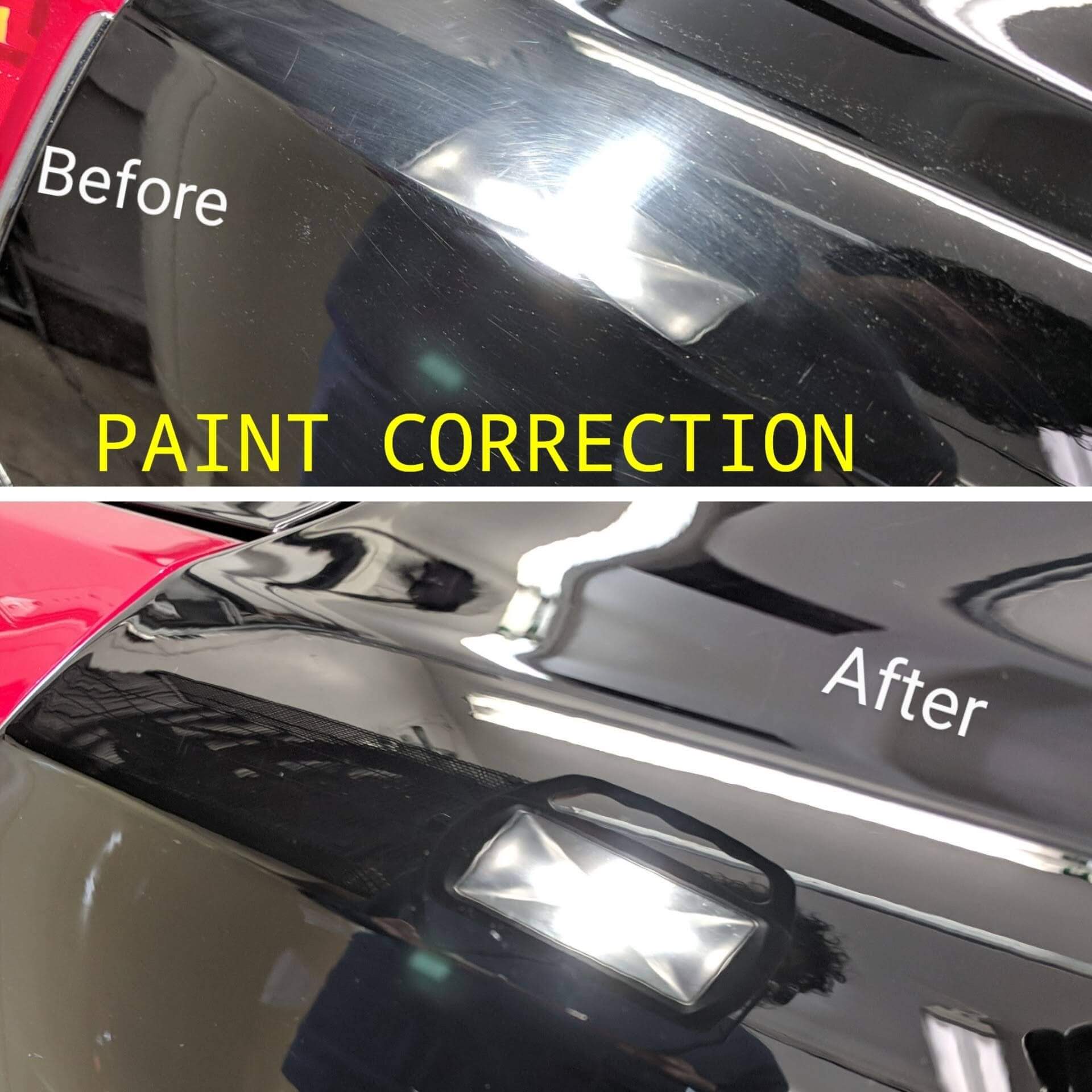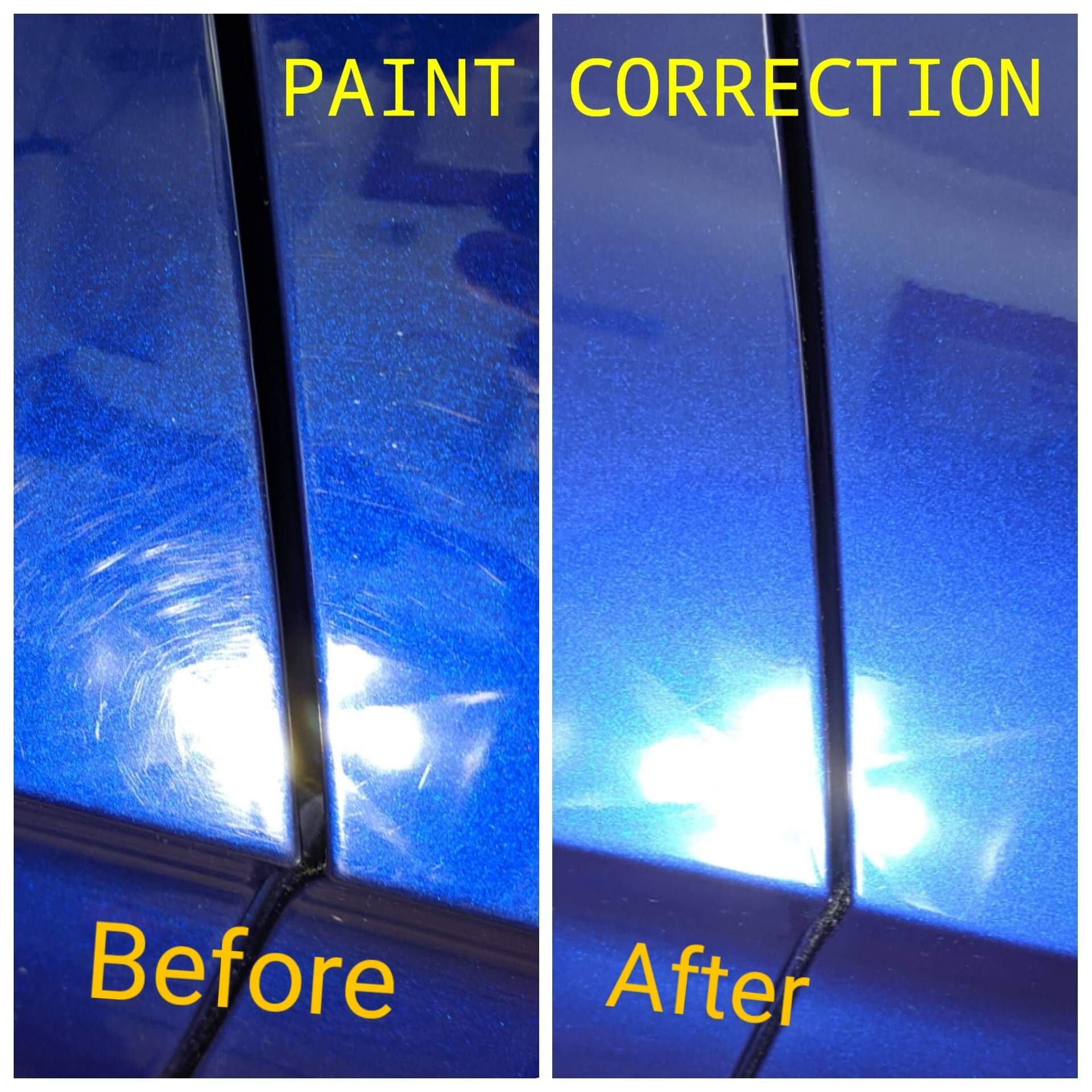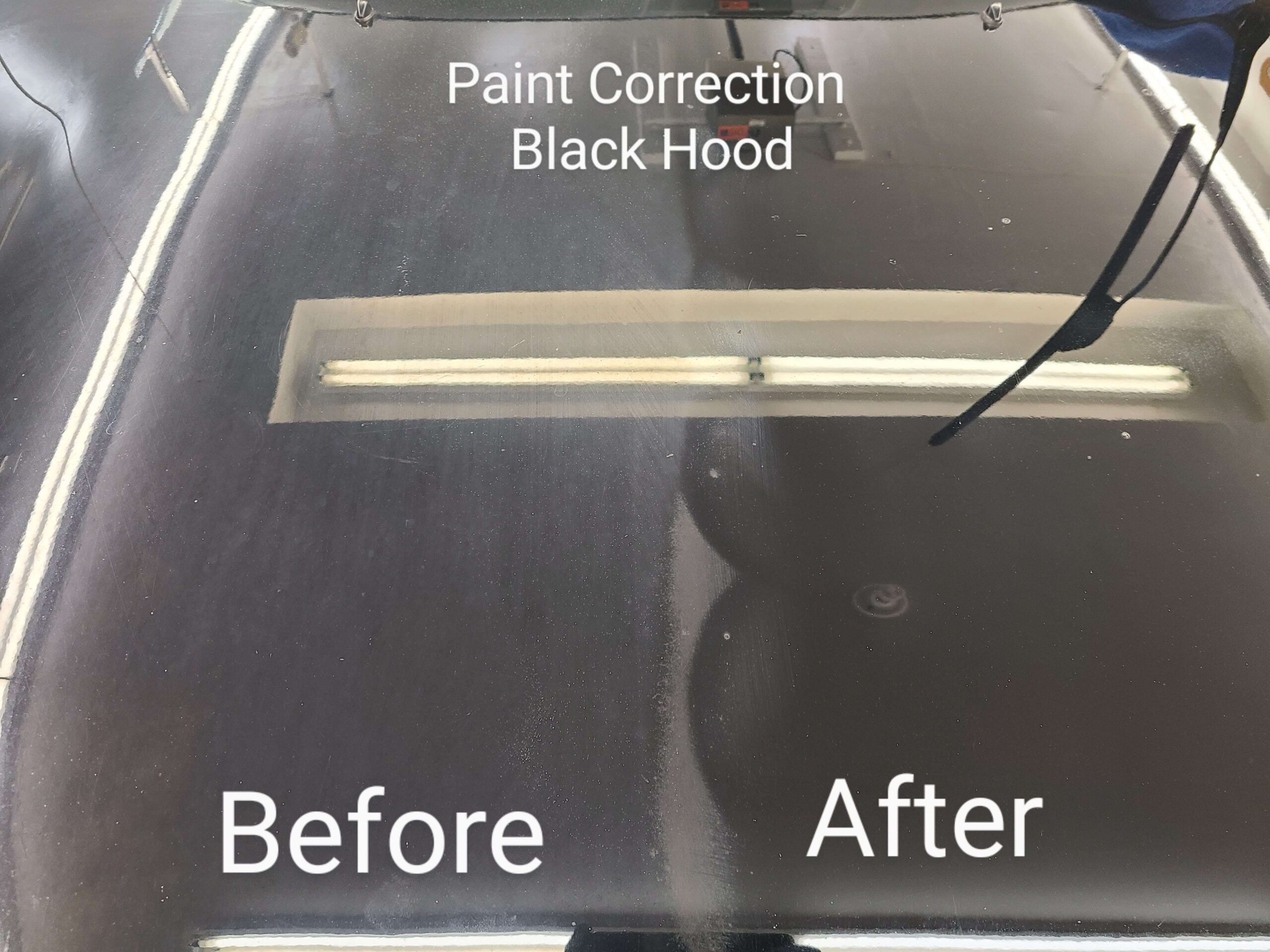




Are you tired of seeing scratches and swirl marks on your car’s paint? Do you long for that showroom shine and flawless finish? Look no further than the art of paint correction, where expert precision can transform your car’s appearance like magic. With the right techniques and tools, skilled technicians can restore your paint’s original shine, removing imperfections and enhancing its overall aesthetics.
Paint correction is a meticulous process that involves removing defects from the top layers of the paint or clearcoat, such as light scratches, swirl marks, oxidation and the countless other types of damage that can happen to your finish. These imperfections are gently erased by carefully polishing the surface, revealing a smooth, reflective finish that sparkles in the sun.
Whether you’re a perfectionist, a car enthusiast, or someone who wants your vehicle to look its best, paint correction is the secret to achieving a stunning shine. From small touch-ups to complete transformations, the art of paint correction is a combination of science and skill that can make your car look brand new.
In this article, we’ll delve into the world of paint correction, exploring the techniques, tools, and expertise required to achieve stellar results. Discover the art behind this transformative process and unlock the true potential of your car’s shine.
Understanding the Importance of Paint Correction
Your car’s paintwork is about aesthetics and what protects that against environmental elements. Over time, however, it can become damaged and lose its luster. This is where paint correction comes in. By addressing these imperfections, you not only enhance the appearance of your vehicle but also protect the underlying layers.
Paint correction is essential because even minor defects can significantly impact the overall look of your car. Swirl marks, caused by improper washing techniques or abrasive materials, can make the paintwork appear dull and lackluster. Due to everyday wear and tear, light scratches can create an unsightly appearance. Oxidation, caused by exposure to UV rays, can make the paint fade and lose its vibrancy.
Investing in paint correction can revitalize your car’s appearance and protect its value. A well-maintained and flawlessly corrected paintwork can make your vehicle stand out from the crowd, giving it that head-turning factor and making you feel proud whenever you hit the road.
Common Paint Defects and Their Causes
Before exploring the techniques and tools used in paint correction, it’s important to understand the most common paint defects and their causes. This knowledge will help you identify the issues on your vehicle and determine the best approach for correction.
- Swirl Marks: Swirl marks are circular, fine scratches on the paint’s surface. They are usually caused by improper washing techniques, such as using a dirty sponge or towel or using abrasive materials that create micro-scratches. It can also be caused by the popular soft touch beaters in the big tunnel washes. These marks can be especially noticeable under bright lighting and diminish your car’s overall shine.
- Light Scratches: Light scratches are shallow marks that penetrate the clear coat and expose the underlying paint layer. They can occur from various sources, including accidental contact with keys, tree branches, or other objects. While these scratches may be less noticeable than deeper ones, they can still affect the overall appearance of your paintwork.
- Oxidation: Oxidation occurs when the paint’s protective layer breaks down due to exposure to UV rays, pollutants, and other environmental factors. This can result in a dull, faded, or chalky appearance. Oxidation is common in older cars or improperly maintained or protected vehicles.
- Other Defects: Bird droppings, bug impacts, sap, tar, environmental fallout, brake and rail dust, acid rain, road salts and mag chloride to name a few.
Understanding these common paint defects and their causes allows you to assess the condition of your car’s paintwork and determine the necessary steps for correction. Whether you attempt the correction yourself or seek professional assistance, this knowledge will help you achieve the best results.
Tools and Products Needed for Paint Correction
Paint correction requires a specific set of tools and products to effectively remove defects and restore the shine of your car’s paint. Here are the essential items you’ll need:
- Clay Bar or Prep pads: Essential to removing both fine and heavy fall out, overspray,etc… that you don’t want causing further problems in the correction process
- Dual Action Polisher: A dual action polisher is a machine that oscillates and rotates a polishing pad. This tool is essential for effectively removing defects from the paint surface. It provides consistent and controlled polishing action, minimizing the risk of causing further damage. Rotary Polisher: Requires a fair amount of training and is not recommended unless you have acquired that training. YOu can do more harm than good!
- Polishing Pads: Polishing pads come in various levels of aggressiveness, ranging from cutting pads for heavy correction to finishing pads for fine polishing. Selecting the appropriate pad depending on the defects’ severity and the desired correction level is important.
- Polishing Compounds: Polishing compounds are abrasive formulations designed to remove defects from the paint surface. They come in different levels of abrasiveness, allowing you to choose the right compound based on the severity of the defects. Selecting a compound that matches the paint’s hardness is crucial to avoid excessive paint removal.
- Wet or Dry Sanding: Some defects require this art. With the modern clearcoat being so thin, this can actually be a better solution combined with buffing for some problems, but can also permanently damage your finish if you don’t know what you’re doing. Best left to the professionals.
- Microfiber Towels: Microfiber towels are essential for removing polish residue and achieving a streak-free finish. They are highly absorbent and gentle on the paint surface, reducing the risk of inducing new defects.
- Paint Thickness Gauge: A paint thickness gauge is a handy tool for measuring the thickness of the paint layers. It helps determine the amount of correction that can safely be performed without risking paint damage.
- Protective Products: After paint correction, protecting the newly restored finish is important. A quality paint sealant or wax will help preserve the shine and provide a protective barrier against environmental elements. Newer ceramic products provide a far superior protection. The over the counter products work well, but don’t last much longer than waxes or sealants, but tend to be easier to use.. Professional ceramic coating products require training as well because they actually cure harder than your clearcoat and if not done correctly, can cause a whole new set of problems!
Having the right tools and products is crucial for achieving professional-grade results in paint correction. Invest in high-quality equipment and materials to ensure the best outcome for your car’s paintwork.
Tips and Techniques for Achieving a Flawless Finish
Achieving a flawless finish requires skill, knowledge, and techniques in paint correction. Here are some tips and techniques to help you transform your car’s shine with expert precision.
- Assessing the Paint’s Condition
Before starting the paint correction process, it’s important to assess the condition of your car’s paintwork. Inspect the surface for scratches, swirl marks, or oxidation. Identifying the extent of the imperfections will help determine the level of correction needed. - Washing and Decontaminating the Surface
A clean and decontaminated surface is essential for effective paint correction. Start by washing your car thoroughly using a pH-neutral shampoo and a microfiber wash mitt. This will remove dirt, grime, or loose contaminants from the surface. After washing, it’s crucial to decontaminate the paint using a clay bar or a synthetic clay mitt to remove embedded contaminants like tar, tree sap, or industrial fallout. - Choosing the Right Polishing Compound
Selecting the right polishing compound is key to achieving a flawless finish. Different compounds are available, ranging from heavy-cutting compounds for severe defects to fine-polishing compounds for minor imperfections. Consider the hardness of your car’s paint and the severity of the imperfections when choosing the appropriate compound. - Using the Correct Polishing Technique
The polishing technique plays a significant role in paint correction. When using a machine polisher, it’s crucial to maintain a steady and even pressure, ensuring that the pad is making proper contact with the paint surface. Work in small sections and make overlapping passes to ensure uniform correction. Remember to let the machine do the work and avoid applying excessive pressure, as this can cause damage to the paint. - Monitoring the Paint’s Temperature
The heat generated during the polishing process can affect the paint’s integrity. Monitoring the paint’s temperature is important to avoid any potential damage. If the surface feels too hot to touch, take a break and allow it to cool down before continuing. Working in a well-ventilated area is also advisable to prevent excessive heat buildup. - Finishing with a High-Quality Sealant, Wax or Ceramic Coating
Once the paint correction process is complete, protecting the newly restored finish is essential. A high-quality sealant, wax or ceramic coating will enhance the shine and provide a protective barrier against environmental contaminants. Choose a product that suits your preferences and follow the manufacturer’s instructions for application.
Professional Paint Correction Services vs. DIY Approach
While some car owners may choose to tackle paint correction themselves, there are distinct advantages to opting for professional services. Let’s compare the benefits of professional paint correction against the DIY approach.
Benefits of Professional Paint Correction Services
- Expertise and Experience: Professional paint correction technicians are trained to identify and correct paint defects. They possess the necessary expertise and experience to achieve exceptional results.
- Specialized Tools and Equipment: Professional paint correction services can access specialized tools and equipment that may be limited to the average car owner. These tools can significantly improve the quality of the paint correction process.
- Time, Value and Convenience: Paint correction is a time-consuming process that requires patience and attention to detail. Opting for professional services can save valuable time, allowing you to leave the task to experts while focusing on other priorities. It can also save you money. Fixing improperly done work can be far more expensive than the original job would have been in the first place.
- Warranty and Customer Satisfaction: Reputable paint correction services often provide warranties for their work, ensuring customer satisfaction. If any issues arise after the service, you can rely on the warranty to address them promptly.
Benefits of the DIY Approach
- Cost Savings: Undertaking paint correction alone can save you money compared to hiring professional services. However, it’s important to consider the potential risks and limitations associated with the DIY approach. Fixing improperly done work can be far more expensive than the original job would have been in the first place.
- Learning Experience: For car enthusiasts or those interested in learning the art of paint correction, taking on the task yourself can provide a valuable learning experience. It allows you to gain firsthand knowledge and develop your skills.
- Control and Flexibility: By performing paint correction yourself, you can fully control the process and tailor it to your specific preferences. This level of control and flexibility may be appealing to some car owners.
- Satisfaction of Accomplishment: Successfully completing a paint correction project yourself can be incredibly satisfying and rewarding. It allows you to take pride in the transformation you have achieved.
Whether to choose professional paint correction services or the DIY approach ultimately depends on budget, time availability, skill level, and personal preference. It’s important to weigh the pros and cons before making a decision.
Frequently Asked Questions about Paint Correction
Conclusion
Paint correction can transform your car’s shine and take it to a new level. Whether you tackle the process yourself or seek professional services, the key is approaching it carefully, precisely, and with the right techniques. By investing time, effort or money into paint correction, you can unlock the true potential of your car’s appearance and enjoy a flawless, showroom-worthy finish that turns heads wherever you go.

